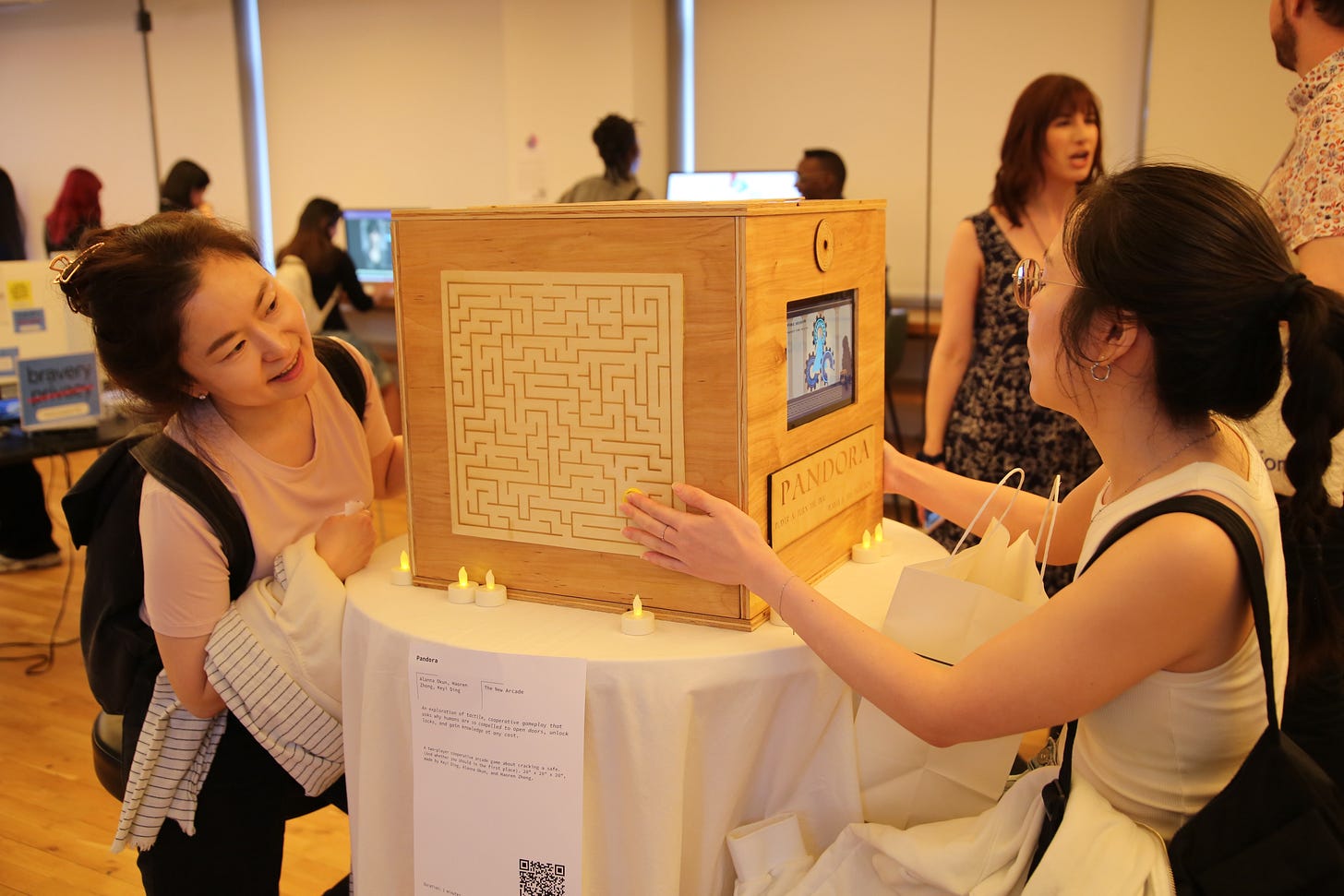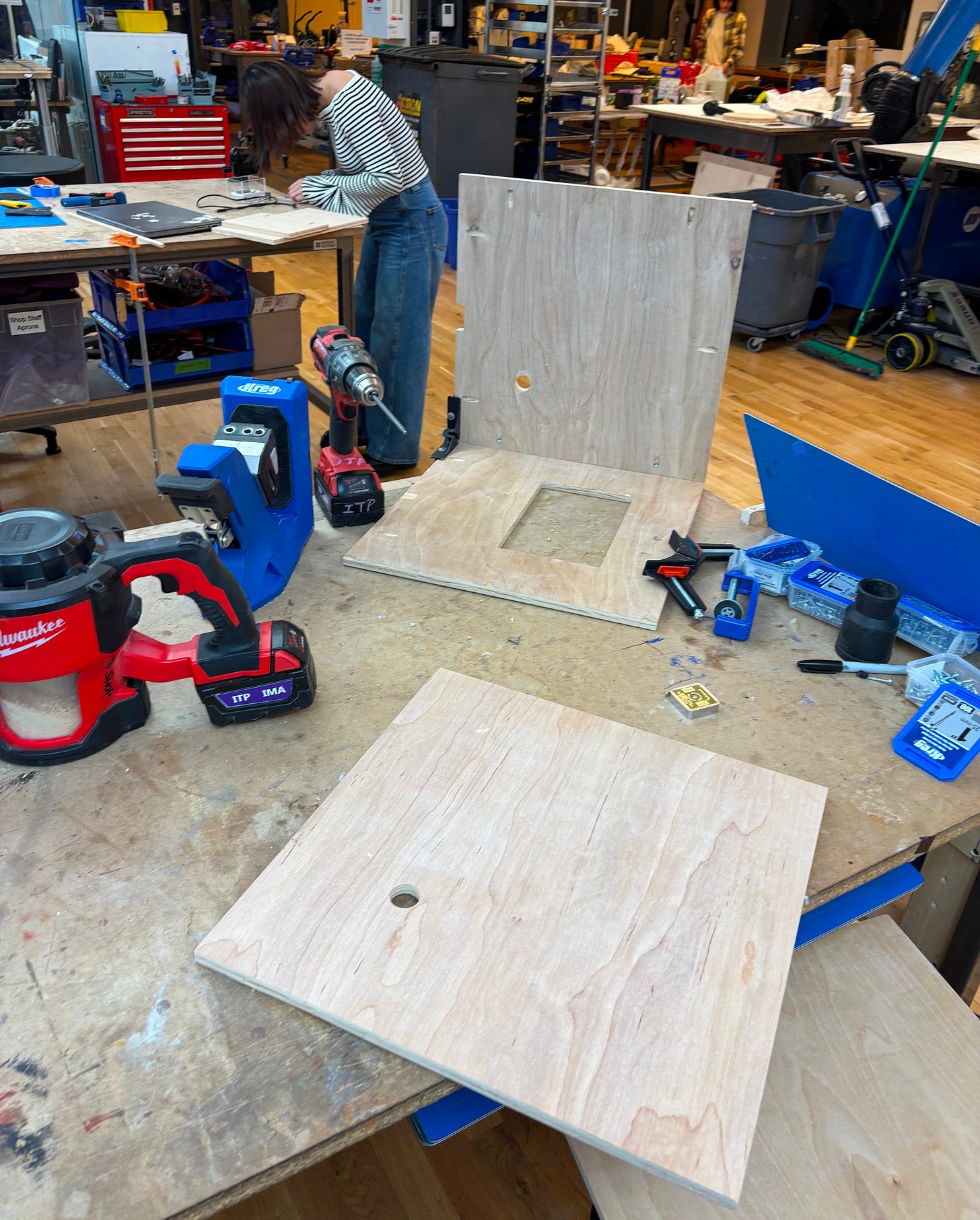Build a box. Then, build another box.
On the end of my first year of grad school + making my first arcade game.
Hi! I’m Alanna Okun, a writer, crafter, and programmer living in New York City. I recently left a twelve-year career in journalism to pursue a master’s degree in creative technology. I’ve been teaching myself to make games and other interactive work for a few years now; I document that process in this newsletter.
I finished the first year of my graduate program last month. The entire time I was there, I faced the same question, from friends and former colleagues and fellow students: What are you learning? Honestly, it’s been tough to answer!
Everyone in my program — which bills itself as “The Center for the Recently Possible” — comes from drastically different backgrounds. And the spread of academic offerings is intentionally wide-ranging; there isn’t a single person who takes an identical path through as another, so we all wind up with divergent skill sets and areas of focus.
Some people worked as engineers before coming here; others have fine arts degrees; they’ve been teachers, musicians, entrepreneurs, or else they’re hoping to be on the other side of our time here. Some throw themselves into learning 3D modeling, or frontend development, or how to make large-scale kinetic light sculptures. Some combine all of the above.
Two years is a short enough stint that you have to buckle down and focus, or else risk going broad in a bunch of various disciplines without going deep in any. That’s not inherently a negative, but it’s never seemed to me like the most efficient use of the limited time we have.
After two semesters, I’ve come to think of my “major,” as it were, as Weird Game Design. (That likely won’t come as a surprise to anyone who’s followed my work or, like, talked to me at all in the past few years.) That question — what am I here to study? — became much easier to answer when I looked back, took inventory of what I’ve learned, and noticed where I’d been drawn to apply it.
Every class I took this semester had something to do, either overtly or tacitly, with the creation of gamelike artifacts.
I worked with a team to create a video game, bespoke controls, and the arcade cabinet it lives inside in a demanding, extremely fun class called The New Arcade.
I read, played, and created works that employ branching, choice-based, and otherwise nonlinear ways to tell stories in Computational Approaches to Narrative, which some classmates and I affectionately called “English Class for Game Nerds.”
I learned to make browser games and websites where I can house and enhance the written, playable work I’ve been creating in Web Art as Site.
I read a 900-page electronics textbook and spent twelve weeks learning to build circuits in Electronics for Inventors, which kicked my ass, gave me a great deal more confidence when it comes to prototyping, and forced me to ask for help early and often.
It was all so much fun. I loved every day. Even when I was cranky or crampy or dizzy from huffing sawdust and solder, I learned something, and I remembered that I could learn something, and I always ended the attempt somewhere further than where I’d started. By the end of the semester, I’d made the thing that best articulated what I mean when I say “Weird Game Design:” an actual, honest-to-God game, that people could actually play.
By far the most difficult and most rewarding project I worked on all semester was for The New Arcade. Along with my classmates K.E. Ding and Haoren Zhong, we made a two-player cooperative game where you try to crack a safe. We called it Pandora, and themed it along the lines of the myth of Pandora’s box.
Here is how it works:
Player A sits on one side of the 20” x 20” x 20” cube, facing a door secured by a combination lock.
Their job is to turn the dial one way or the other, following the spoken instructions of Player B, who is seated on the opposite side of the box, facing a screen.
On the screen are three gears, each “activated” randomly over the course of the game’s 90-second play window; when active, a given gear’s movement is controlled by Player A’s turning of the dial. The goal is to align all three gears so they form a triangular shape between them.
This is where the real gameplay happens: Player A only knows whether, say, to turn the dial clockwise if Player B tells them clearly and quickly, so much of the interaction is between the players cobbling together a sort of linguistic shorthand to give and receive instructions.
If all three gears align within the time limit, the door to the safe opens, revealing a prize inside. (As of now, the prize is Hershey Kisses, but we’ve got some ideas for improvement there.)
I was in charge of fabrication, which meant learning how to build a functioning safe out of plywood in about three and a half weeks. When I asked my professor Mark how to even wrap my head around learning what I’d need to in order to pull it off, he gave me some advice: “Build a box. Then, build another box.”
This is a fundamental distillation of every lesson I’ve learned this year: you learn how to make something by making it. This goes for websites and game design and sculptures and shelving. Just the other week I talked to a friend about how it applies to crocheting a blanket. Often, it means remaking the thing a number of times, prototyping and iterating until you get it where it needs to be or at least close enough.
So I built a box. In the process I learned to use a CNC router, a pocket jig, a belt sander, a drill press, and about half a dozen other tools. I got much more comfortable with CAD software and with Unity. I did cry (twice), when I was overwhelmed or didn’t understand how best to use a given tool. Each time what saved me was the patient guidance of someone who knew more than I did, who broke down each step and put the power back in my hands. It made me want to do that for someone else.
We’ve now had the chance to present Pandora in public a handful of times. By now around 300 teams have attempted it (about 40 successfully, by my count), and the feedback we’ve gotten from those early players — who ranged, also by my estimate, from ages 8 through 65 — has been invaluable.
I was extremely nervous leading up to those events. I have an instinct to keep my work to myself until it’s “perfect,” or at least “finished,” and the pace and demands of school have meant that nothing I make gets the chance to reach that (imaginary) level before it has to hit the air. I find myself making excuses and overexplaining, wanting whomever is interacting with my work to understand that I know it’s not ready, I see the mistakes and the problems too.
At first, I approached the Pandora playtests with that energy. But pretty quickly, something began to shift: people didn’t need us to explain ourselves quite so much. They’d sit down at the box across from a friend or stranger and start to tweak and tinker; they’d turn the dial this way and that, they’d shout at their co-player to give better or louder directions, and they would play. The game wasn’t actually a game, I realized, until they did.
By the end of the gauntlet, I was able to stand back entirely and let players teach each other. I watched them cobble strategies together; I watched groups of friends approach the box pair by pair until they were at last successful, popping Hershey Kisses into their mouths with a genuine sense of victory.
Having that many people play Pandora exposed its weaknesses (it’s too hard, for one thing, and needs to be manually reset whenever anyone wins) but none of them feel like shortcomings so much as opportunities, concrete things to improve upon. We’re likely going to keep working on it through the summer, in hopes of bringing it to some game conferences next year and beyond.
Inviting others to play means giving up, at least in the moment, my own sense of control. It’s so hard, and so rewarding. In many ways, I think that’s what I’ve been after since heading toward this new, diffuse future: a strategic unclenching, a reevaluation of what it is to make meaningful, expressive creations. So much of what happens in games, and in interactive work more generally, is on the other side, in the in-between. That can only be revealed and refined between people, in the messy, vulnerable middle stages when all you’ve got is a draft.
I built a box. Time to build another.



